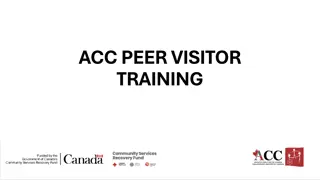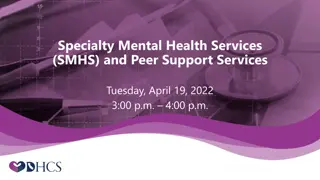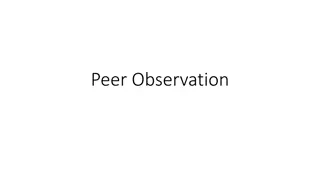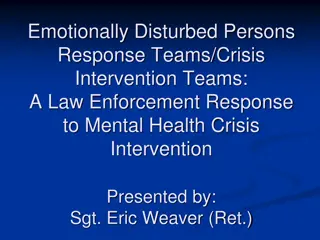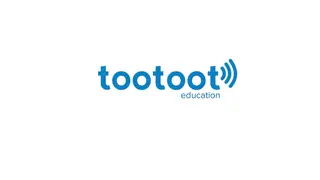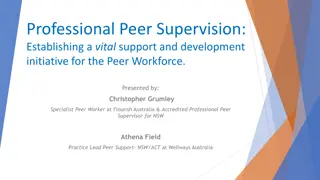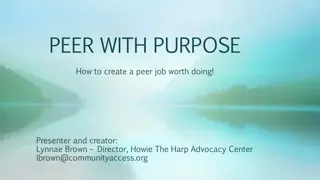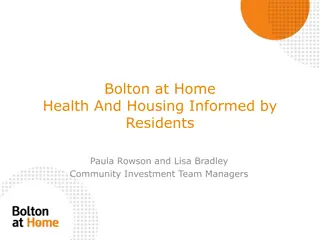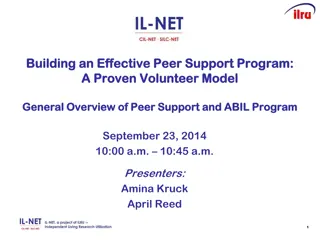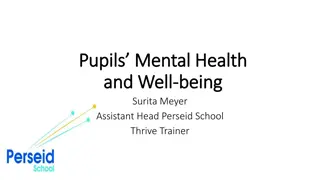The Bridge: A Peer Navigator Intervention for Improving Adult Mental Health
The Bridge intervention focuses on addressing health disparities in adults with serious mental illness by connecting them to comprehensive health care services, fostering engagement, and empowering self-management. Through a structured approach involving peer navigation, consumers are supported in accessing and utilizing primary care effectively, leading to improved health outcomes.
Download Presentation

Please find below an Image/Link to download the presentation.
The content on the website is provided AS IS for your information and personal use only. It may not be sold, licensed, or shared on other websites without obtaining consent from the author. Download presentation by click this link. If you encounter any issues during the download, it is possible that the publisher has removed the file from their server.
E N D
Presentation Transcript
The Bridge: A Peer Navigator Intervention for Improving the Health of Adults with Serious Mental Illness Dr. John S. Brekke Dr. Erin Kelly
To deal with the health disparities in this population we need: Top-down: A healthcare system that is receptive and responsive Bottom up: Consumers that are ready to be active in the system and in their own health care.
Peer Health Navigation Intervention: The Bridge A comprehensive health care engagement and self-management intervention
Comprehensive: Connect consumers to primary care, specialty health care, and substance abuse services
Engagement: Many individuals with serious mental illness are not successfully engaging a consistent primary health care provider (or a health home), or have given up trying to access and use outpatient primary care
Self-Management: Train and empower consumers to be assertive self-managers of their health care so that their interactions with care providers can be more effective and consistent
In vivo approach Develops self-management skills in real world health care settings
Intervention Mantra For them (modeling) Navigator performs task, Consumer observes With them (coaching) Consumer performs task, Navigator coaches By them (fading) Consumer self-manages healthcare, Navigator supports as needed
3 Phases of Intervention Phase 1 Phase 3 Intensive 3 months of assessment, modeling, coaching Ongoing support and boosters as needed Phase 2 3 months of fading and consumer self- management
Challenge Points Consumer Challenge Points to Successful Health Care Outcomes Health and Wellness Needs Scanning environmental resources Initial provider contact Treatment plan and follow up Consumer awareness Getting to the appointment Waiting room experience Exam room experience 1. Work with service coordinators and mental health providers to assess consumer need for navigation. 2. Conduct health care service screening with consumers. 3. Help with insurance benefits as necessary. 1. Assist with making appointments (role play and in vivo). 2. Coach consumer in making appointments. 1. Provide appointment reminders. 2. Assist with and coach regarding transportation needs. 1. Help with provider forms. 2. Model interactions with staff and other patients (role play and in vivo). 3. Coach interactions with staff and patients (in vivo). 4. Act as stigma buffer 1. Model interactions with medical personnel (role play and in vivo). 2. Coach interactions with medical personnel (in vivo). 3. Help consumer communicate needs. 4. Act as stigma buffer 1. Assist with treatment compliance, treatment plan, follow-up or specialty care, prescriptions. 1. Conduct health and wellness assessments with consumers. 2. Work with consumers to set health and wellness goals and the means to achieve those goals. 3. Provide health education tailored to consumer s goals. 1. Find providers and/or health clinics. 2. Develop relationships with providers & clinics. 3. Find insurance and/or benefits information Navigator Role
Critical Elements of Health Navigation Consumer Screening & Engagement Assessment Goal setting (Healthcare, Wellness/Lifestyle) Preparing for the Medical Appointment Navigating the Medical Appointment Reviewing the Appointment Follow up Care Plan Self Management of Health Care
Peer Health Navigator Skills Engaging and connecting with consumers Assessment and building commitment for self management Making a collaborative plan for the consumer s health care based on the consumer s goals Accessing and utilizing health care Modeling, coaching, fading
Health Navigation Skills Consumers Develop 1. Accessing Medical Services Find medical services Access transportation Make and keep appointments 2. Utilizing Medical Services Prepare for the medical visit Communicate with medical staff Follow treatment plan
3. Maintaining health Be organized about their health care Achieve Health and Wellness Goals Prioritize health needs 4. Asking for support to overcome roadblocks 5. Managing emotions and symptoms during medical activities
History of Bridge 3-year pilot research project started in 2008 Project Bridge team from the USC School of Social Work in collaboration with Pacific Clinics Funded by: UniHealth Foundation NIMH Clinical and Translational Science Institute at USC
Health Care Problems at Beginning of Pilot RCT Of 24 health problems/symptoms Almost 100% Over 75% Almost 50% 2+ medical problems 5+ medical problems 10+ medical problems
Summary of Findings The Peer Health Navigation Intervention ( Bridge ) shows impact and promise for: Reducing health problems Reducing bodily pain related to health problems Impacting the use of medications Shifting the locus of health care from ER and UC to outpatient primary care
Pilot RCT Findings Positive findings for the intervention in terms of: Acceptability to clients and agency staff Tolerability for clients Feasibility of integration into clinic and teams Feasibility for peer providers
Interviews with Peer Health Navigators People who provide critical services receive benefits themselves (the helper principle ) Increased self-esteem Newfound confidence High job satisfaction Peer Health Navigators were more likely to obtain medical care for their own health care needs after navigating consumers
PCORI funded Study Brekke PI, Kelly Co-I 150 consumers have been randomized to immediate HN or 6 month wait-list Interviews at BL and every 6 mo for 18 mo 6 months of peer health navigation 3 HNs with caseloads of about 20 each One agency site within Pacific Clinics
Stages for implementing and sustaining a peer health navigator intervention at a mental health agency: Stage 1 Preparethe agency admin. staff and supervisors Stage 3 Integrate the intervention into the agency practices Stage 2 Train Health Navigators (using manual)
Implementation Manual With grant support from the UniHealth Foundation we are manualizing and testing the feasibility of an implementation manual for use by agency practitioners
Bridge Team John Brekke, PhD, PI; USC Lou Mallory, Peer Health Navigator Supervisor; Pacific Clinics Erin Kelly, PhD, Co-I; USC Heather Cohen, MPP, Project Director; USC Laura Pancake, MSW, Corporate Director; Pacific Clinics Holly Kiger, RN, MSN; USC Toni Rainey, Francisco Espinoza, Tamara Ra: Peer Health Navigators; Pacific Clinics Crystal Stewart, Jorge Avila, Research Assistants; USC
Systematic Review of Self- Management Interventions Kelly, Brekke et al., Psychiatric Services, In Press 14 studies involving self-management of medical care and health by individuals with SMI Promising evidence that consumers can collaborate with health professionals or be trained to self- manage their health and health care. 8 of the 14 studies used a self-report measure and 5 found evidence of improvement Evidence supports the use of mental health peers or professional staff to implement health care interventions.
Electronic Health Records The federal government has recently incentivized the adoption of electronic health records (EHR) The goal is to improve communication between mental health and medical providers Those with SMI are often excluded from studies evaluating the effectiveness of EHR
Personal Health Records Personal health records can refer to: a) Records accessible to a patient but is a part of the EHR system of their medical provider b) A standalone record, maintained by the patient, such as with Microsoft s HealthVault application c) Health information records accessible to a patient but maintained by a mental health agency
Benefits of Personal Health Records Could improve the efficiency and effectiveness of care Empower individuals to become more active participants in their care Reduce communication errors across providers Could improve individuals adherence to treatment and improve their self-management of care long-term
Serious Mental Illness and PHR Those with SMI are often excluded from studies about PHR Potentially excluding a group that could derive a great deal of benefit from maintaining a PHR Multiple doctors Inconsistent insurance/access Poor record keeping Multiple chronic conditions Complicated treatment regimens
Study Overview Phase 1: Medical providers, mental health providers, and consumers are interviewed about their perceptions of EHR and provide feedback on a PHR based out of a mental health clinic (n =25). Phase 2: Up to 40 participants receive a modified form of the Bridge health navigator program that includes access to a PHR.
Preliminary Results In the Phase 1 interviews: Medical providers, mental health providers, and consumers are largely enthusiastic about consumers having access to their information Estimates of how many consumers could use it varied considerably and was thought to depend heavily on how they were trained to use it
Preliminary Results Consumers report feeling empowered Mental health providers thought that some consumers could use the information effectively Medical providers thought it could improve efficiency and wanted more information to assist in SSI claims, diagnostic information, medication management


